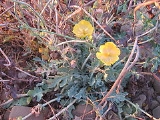
Glaucium
Encyclopedia
Glaucium is a genus
of about 25 species of annual
, biennial
or perennial
herbaceous
flowering plant
s in the family Papaveraceae
, native to Europe
, north Africa
, and southwest and central Asia
. The species commonly occur in saline habitats, including coast
s and salt pans.
Genus
In biology, a genus is a low-level taxonomic rank used in the biological classification of living and fossil organisms, which is an example of definition by genus and differentia...
of about 25 species of annual
Annual plant
An annual plant is a plant that usually germinates, flowers, and dies in a year or season. True annuals will only live longer than a year if they are prevented from setting seed...
, biennial
Biennial plant
A biennial plant is a flowering plant that takes two years to complete its biological lifecycle. In the first year the plant grows leaves, stems, and roots , then it enters a period of dormancy over the colder months. Usually the stem remains very short and the leaves are low to the ground, forming...
or perennial
Perennial plant
A perennial plant or simply perennial is a plant that lives for more than two years. The term is often used to differentiate a plant from shorter lived annuals and biennials. The term is sometimes misused by commercial gardeners or horticulturalists to describe only herbaceous perennials...
herbaceous
Herbaceous
A herbaceous plant is a plant that has leaves and stems that die down at the end of the growing season to the soil level. They have no persistent woody stem above ground...
flowering plant
Flowering plant
The flowering plants , also known as Angiospermae or Magnoliophyta, are the most diverse group of land plants. Angiosperms are seed-producing plants like the gymnosperms and can be distinguished from the gymnosperms by a series of synapomorphies...
s in the family Papaveraceae
Papaveraceae
Papaveraceae, informally known as the poppy family, are an economically important family of 44 genera and approximately 770 species of flowering plants in the order Ranunculales. The family is cosmopolitan, occurring in temperate and subtropical climates, but almost unknown in the tropics...
, native to Europe
Europe
Europe is, by convention, one of the world's seven continents. Comprising the westernmost peninsula of Eurasia, Europe is generally 'divided' from Asia to its east by the watershed divides of the Ural and Caucasus Mountains, the Ural River, the Caspian and Black Seas, and the waterways connecting...
, north Africa
Africa
Africa is the world's second largest and second most populous continent, after Asia. At about 30.2 million km² including adjacent islands, it covers 6% of the Earth's total surface area and 20.4% of the total land area...
, and southwest and central Asia
Asia
Asia is the world's largest and most populous continent, located primarily in the eastern and northern hemispheres. It covers 8.7% of the Earth's total surface area and with approximately 3.879 billion people, it hosts 60% of the world's current human population...
. The species commonly occur in saline habitats, including coast
Coast
A coastline or seashore is the area where land meets the sea or ocean. A precise line that can be called a coastline cannot be determined due to the dynamic nature of tides. The term "coastal zone" can be used instead, which is a spatial zone where interaction of the sea and land processes occurs...
s and salt pans.
List of species
- Glaucium afghanicum
- Glaucium arabicum
- Glaucium bracteatum
- Glaucium calycinum
- Glaucium caricum
- Glaucium corniculatum, Horned poppy (Sea poppy, Yellow horned poppy), native of Western Europe.
- Glaucium cuneatum
- Glaucium fischeri
- Glaucium flavumGlaucium flavumGlaucium flavum is a summer flowering plant in the Papaveraceae family, which is native to Northern Africa, Macaronesia, temperate zones in Western Asia and the Caucasus, as well as Europe. Habitat: the plant grows on the seashore and is never found inland...
, Yellow horned poppy, native of Western Europe. - Glaucium grandiflora, Horned poppy, native of western Mediterranean.
- Glaucium judaicum
- Glaucium leptopodum
- Glaucium luteum
- Glaucium persicum
- Glaucium phoenicum
- Glaucium pulchrum
- Glaucium refractum
- Glaucium squamigerum

